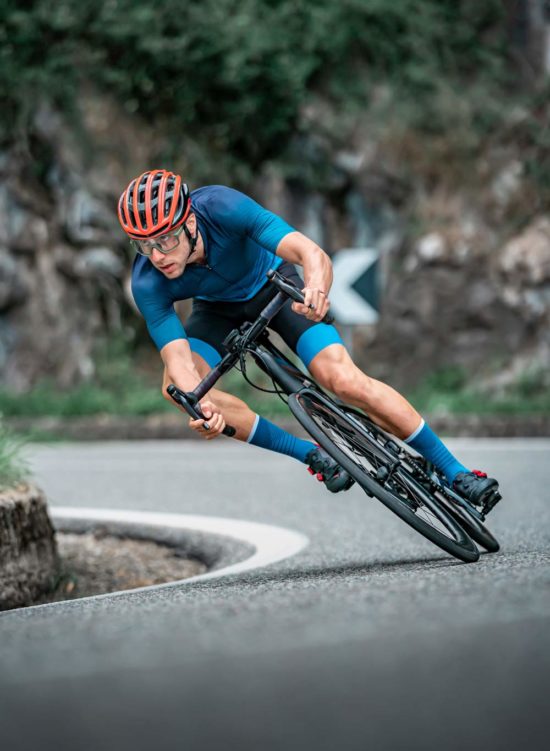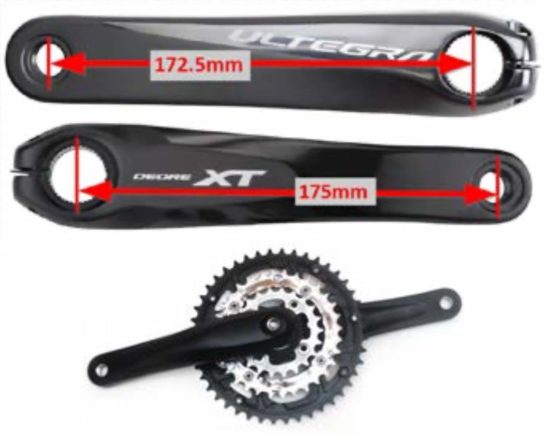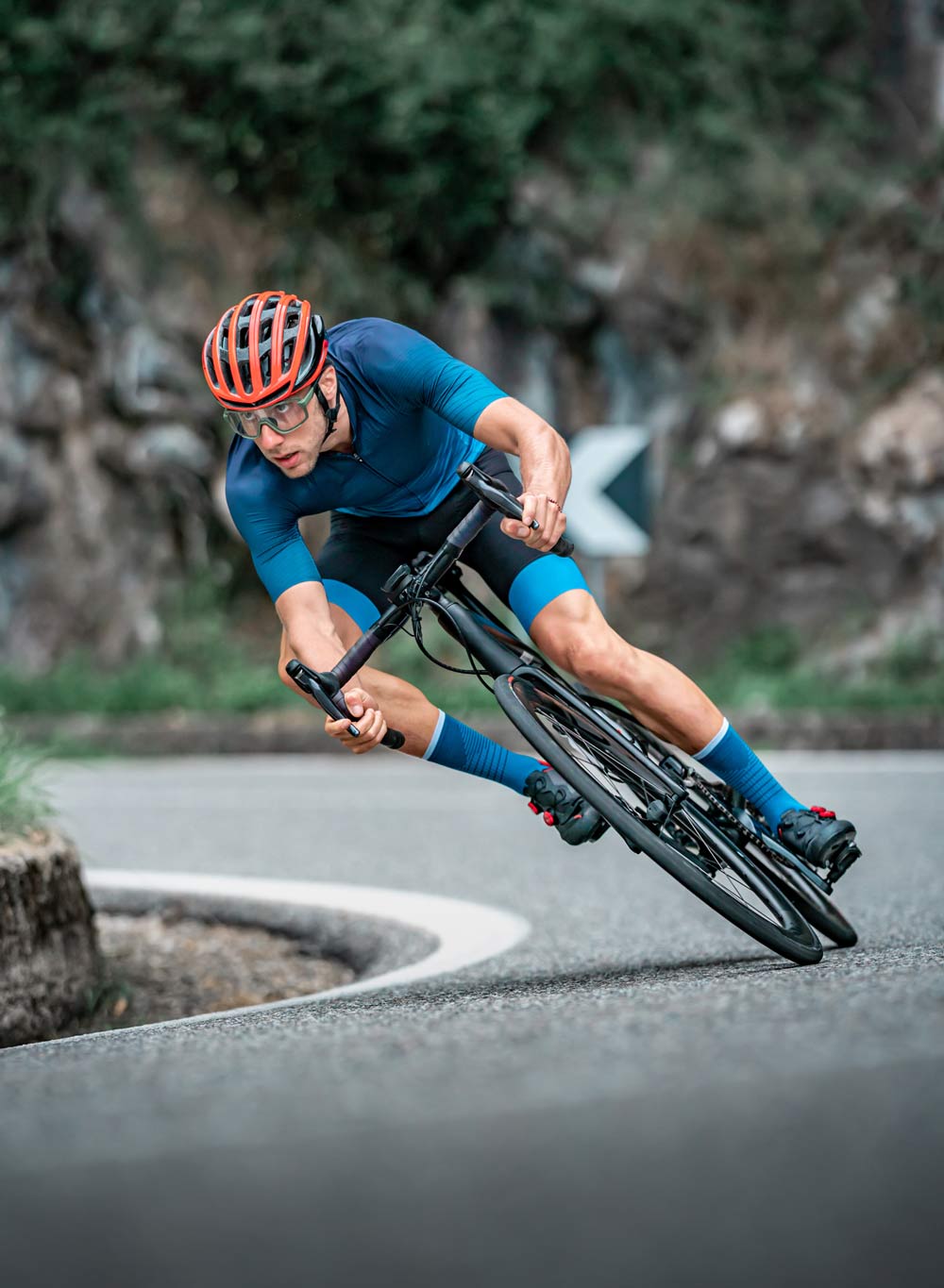 By Rick Schultz
By Rick Schultz
Having performed thousands of bike fits, I now believe that the bicycle’s crank arm length is the most important factor when performing a bike fit. Every other anatomical dimension and joint angle is based upon the length of the crank arms; therefore, this is the first factor to address when performing a bike fit.
Having been a professional bike fitter for the past 12 years, I have seen and fit cyclists of every size and shape. As a result, I can assure you that every cyclist needs a custom bike fit because no 2 cyclists are the same. Even at the same overall height, each cyclist will have a slightly different torso-to-leg length ratio and maybe even a slightly different femur-to-tibia length ratio, so it is absolutely necessary that each cyclist undergo a fit that starts with evaluating their leg length. Like medical professionals everywhere, top-tier bike fitters follow the motto: “first, do no harm.” Afterall, once a cyclist has gone through a comprehensive professional bike fitting process, they should be at least as comfortable and safe on the bike as they were before they came in.
This paper will focus on road, gravel, and especially triathlon/time trial (Tri/TT) bicycles, and the importance of crank arm length versus frame size. Why? Up to a point, frame size can be ‘modified’ by moving the saddle up or down, substituting a longer or shorter stem, changing the type, shape, or even the rotation of the handlebars. Tri/TT bikes are even more adjustable by changing the reach, angle, twist and/or, rotation of the aero bars. by changing the reach, angle, twist, and/or rotation of the aero bars. Crank arms, on the other hand, come in fixed sizes and cannot be changed, meaning that a typical crankset comes with a set of crank arms of a single size. Crank arms are the levers to which the pedals are attached. While there are some aftermarket solutions, these are not part of the standard crankset provided by the component manufacturers. For the past several seasons, I have seen the same one-size-fits-all crank arms on almost every road bike regardless of frame size. As we wrote in our July 2019 article,1 crank arms that are too long can be a leading contributor to chronic knee and hip pain.
Bicycle Riding = Physics
The next item that became clear was that while every cyclist who came into the fit studio had their own reason for a bike fit, a large number of these cyclists came in due to pain experienced during cycling. Complaints were expressed about hand numbness, neck pain, shoulder pain, lower back pain, foot pain and, toe numbness, but the greatest number of cyclists complained of knee pain. Looking further into why, we found that crank arm length played a crucial factor.1
Propelling a bicycle forward requires Power which is made up of Force and Velocity. The Power formula is P=F×V, where F=the amount of Force, i.e., how hard the cyclist is pushing down on the pedals/crank arms, and V=Velocity, i.e., cadence, how fast the cyclist is spinning the pedals. A high F–low V draws more on the body’s neuromuscular system to propel the bicycle forward and is normally associated with LONG crank arms, while a low F–high V draws more on the body’s cardiovascular and respiratory systems2 to propel the bicycle forward, and this is normally associated with SHORT(er) crank arms. It is interesting to note that the same amount of power can be output from each of the above. For example, a cyclist wants to output 10 units of power. They can generate the 10 units by 5F × 2V or 2F × 5V. Using either, the cyclist is still putting out 10 units of power. It’s just which ‘energy system’ the cyclist wants to use. But there are 2 things to consider using this formula.
- The formula falls apart at the extremes, eg:
- As the crank arms become shorter, they can spin faster—to the point that you are losing leverage (Force) faster than cadence is increasing. You will eventually get to a point where they cannot spin any faster.
- As the crank arms become longer and longer, you are gaining leverage up to the point that you are losing cadence faster than you are gaining leverage.
- If the crank arms become longer, the leg at the 12 o’clock position experiences higher shear and compressive forces at the patellofemoral and tibiofemoral joints with accompanying structures. Prolonged cycling on crank arms that are too long can be a contributor to injury and potentially premature knee surgery/knee replacement.

Figure 1. Common crank arm sizes installed on today’s road (172.5mm) and mountain (175mm) bikes. Credit: bike.shimano.com
How does it feel when the crank arm is too long?
Most road bicycles, triathlon bicycles, and mountain bikes come with crank arms that are too long for the average cyclist. Regardless of frame size, from what we have seen, most manufacturers are putting 172.5mm crank arms onto most road and triathlon bikes, and 175mm crank arms on most mountain bikes (Figure 1).
Through many post-bike fit interviews, cyclists tell me that riding with crank arms that are too long feels like they (a) just can’t get the bike going, or (b) believe something is wrong with the bike, or (c) are exerting lots of force, but the bike just isn’t responding. In summary, they can’t get on top of the gear, and they end up ‘fighting’ the bike the whole ride. This takes all the fun out of riding, not to mention increases stress to the joints of the knee (Table 1). Once correct crank lengths are installed, the most common reply I’ve heard is, “I can’t believe the bike is this easy to ride!”
There are several factors at play here.
(a) Muscles work most efficiently in mid-range.
In a discussion that Mark Deterline of Cycling Utah3 had with aerodynamics and biomechanics expert John Cobb, and exercise physiologist John McDaniel, PhD, John Cobb stated:
“I used to be a big believer in long crank arms, but now I’m going in a different direction. I’m convinced that crank length and pedal rate (i.e., cadence) should be more directly related to one’s natural running cadence and stride length than anything else. Every muscle has a natural contraction rate that will yield maximum efficiency. The game is to keep the muscle in its most efficient extension range and at its most efficient rate of rotation [emphasis mine].” Cobb added, “Subsequently, I worked with a rider who is 6’5″, bringing his crank length down to 165mm’s over three months. He’s gained 65 watts of power.”
I agree 100% with Cobb. For most of my clients’ post-bike fit, with correct crank lengths, they are averaging 50 more watts of power than prior to the bike fit. I have one client, a local cyclist who teaches kinesiology at a major university in California, who is a Category (Cat) 2 road, criterium, and Individual Time Trial (ITT) racer. He is 6’3″ and uses 155mm crank arms on his TT bike and recently won the California State ITT Cat 2 championship.
In the Cycling Utah3 article, John McDaniel explained, “Every muscle does two things for which an athlete should strive to determine optimal performance parameters: one is the contraction-relaxation rate (the rate at which the muscle will contract, perform work, then relax), and shortening velocity (the speed at which the muscle is working [a muscle shortens as velocity increases]). These two tasks determine maximum power and maximum efficiency. By varying pedal rate and crank length, we can adapt conditions to the muscular system so that it operates closer to its maximum efficiency or power. Our goal is to do both!”
(b) Too much leverage but not enough cadence.
As said before, the basic power formula is P=F×V, where P=Power in watts, F=Force (how hard you are pushing on the pedals), V=Velocity (how fast you are spinning the pedals, or angular velocity of the cranks).
Most cyclists tend to have a narrow range of cadence in which they are efficient. The longer the crank arm, the larger the pedaling diameter, therefore the distance that the cyclist needs to pedal is farther to make a complete circle and the result is a much slower cadence. The shorter the crank arm, the smaller the pedaling diameter, so there is a shorter distance that the cyclist needs to pedal to make a complete circle. This results in a much faster cadence, helping the cyclist stay within their range of efficiency more easily.
In a study4 that looked at the effects of crank length on power, a set of cyclists rode a predetermined test set where they sprinted on crank arms that varied in length from 120mm to 220mm. The average power was recorded, and it showed that output power varied by only 1.6% between the crank arms lengths of 145mm and 170mm. Outside of these lengths, power varied by 4%. As McDaniel observed in the discussion with Cobb3, “It is interesting to note, however, that the parameters in which max power is produced are often not the same as those that produce max efficiency. This is obvious in cycling where max power is usually produced around 120–130 pedal rpm’s (rotations per minute), yet max efficiency is reached at around 60–70 rpms.”
(c) Less leverage, more cadence, less force, and less stress on the knee
Looking at the power formula, P=F×V, shorter crank arms require the cyclist to spin the cranks faster rather than using brute force to turn the cranks. Less force saves wear and tear on the knees and hips. By using the formula above, the bike fitter should shorten the crank arms so that the cyclist has a good balance of force and velocity AND no over-flexion at the top of the pedal stroke.
(d) Knee pain caused by over-flexion at the top of the pedal stroke
Several studies4-10 looked at the biomechanics and overuse injuries in cycling and concluded that knee injuries were among the most common injuries for both professional and recreational cyclists. Table 2 is a summary of the findings from Clarsen et al.7 In their conclusion, they wrote:
Lower back pain and anterior knee pain are the most prevalent overuse injuries, with knee injuries most likely to cause time loss and lower back pain causing the highest rates of functional impairment and medical attention.7
Shorter crank arm lengths can reduce anterior knee pain by reducing the knee flexion angle at the top (12 o’clock) of the pedal stroke.
Many cyclists suffer from (a) general muscle weaknesses–hips, glutes, core, (b) muscle imbalances–quadriceps, hip flexors, and (c) mobility restrictions, especially the hips and knees. Shorter crank arms can help with hip weaknesses/reduced hip mobility by decreasing the range of motion of the hips during the pedal stroke. Regarding knee mobility, longer crank arms force the knee to flex more and with reduced mobility. In most cases, the knees will move outward at the top of the pedal stroke. Shorter crank arms reduce knee flexion, allowing the knees to track straight throughout the pedal stroke. Bike fitters continue to use the bicycle’s existing (i.e., too long) crank arms and use cleat wedges to force the knees inward. Although the tracking is straightened out, since this is not the natural body position of the cyclist, we hear from our clients that this just displaces pain and potential injury to another part of the body, usually the hips and ankles. With correct (shorter) crank arm length, natural position is achieved as well as a reduction in pain.
One more cause of knee pain in cyclists and runners is the iliotibial band (ITB).8,9 In Erik Dalton’s blog, “Treating Cycling Injuries,” he writes, “The actual cause of ITB pain is an extremely important discovery for manual therapists or sports therapists who work with cyclists and runners. Iliotibial band syndrome is an overuse injury of the connective issues that are located on the outer thigh and knee. If the underlying fat pad is indeed the main cause of our client’s lateral knee pain, it is probably not a good idea to apply compressive forces over the ITB tendon, which is already squashing the inflamed fat pad. Traditional techniques, such as cross-fiber frictioning and ITB fascia-mashing [foam roller], would be contraindicated.”10 Shorter crank arms reduce knee flexion, so the ITB is not pulled as tight, thereby reducing compression to the knee.
(f) Iliac artery occlusion is a potentially life-threatening condition in which partial or complete closure, or blockage of the iliac arterial system obstructs blood supply to the pelvis, or via the connecting femoral artery to the leg and even the genital and gluteal regions.
For a cyclist, the top of the pedal stroke is the issue. Crank arms that are too long create unnecessary hip flexion. This can pinch the tissues in the front of the hip if there is an imbalance of length tension in hip soft tissues. This can lead to FAI (femoral acetabular impingement), soft tissue impingement (hip flexors and adductors mainly) and even iliac artery occlusion in rare cases. Short crank arms open the hip joint more (less flexion at 12 o’clock).
(g) Evening out the left-right (power) balance
During pre-bike fit workups, I use a dual-sided power meter and often see cyclists pedaling at a 60%–40% balance. Most cyclists do not ride with dual-sided power meters so they will not know which leg is pushing harder.
Putting all of these factors together, when crank arms are too long, road/gravel/Tri/TT cyclists are forced to ‘stab’ at the pedals because a smooth high-cadence pedal stroke usually cannot be achieved. Since we usually have a dominant leg, long crank arms coupled with high force on the pedals and a slow cadence can lead to what we see as single leg pain and injury. Since cyclists tend to push harder with their dominant leg and due to the thousands of pedal strokes per ride, overuse injuries occur on the dominant leg. Others tend to push harder with their non-dominant leg causing overuse injuries on this leg. Shorter crank arms reduce the force applied to the pedals allowing for the realization of a higher cadence, which tends to even out the left-right balance.
Conclusion
The length of the crank arms is one of the most crucial factors in a bike fit and is critical in placing the cyclist into the strongest, safest, and least injury-causing position, however, it is the most overlooked adjustment considered.
The advantages to riding with the correct length of crank arms is far reaching. For example, using shorter crank arms, the knees are not being driven up as high (at the 12 o’clock position) and many cyclists mention that any hip pain subsides with the short crank arms as well.
In our opinion, selecting the correct crank arm length should be the first step before any other adjustments are to be made by a bike fitter.
Rick Schultz, MBA, DBA, is a master bike fitter and USA Cycling (USAC) Level 2 Coach and Certified Skills Instructor. He is the owner of Bike Fitness Coaching, San Juan Capistrano, California.
- Schultz R, Schultz A. At all levels and categories of cycling: correct poor crank-arm fit to relieve chronic knee pain (and hip pain). Lower Extremity Review. 2019;11(7):31-41.
- Bloom L. High cadence vs low cadence cycling. Coachlevi.com. Available at https://coachlevi.com/cycling/high-vs-low-cadence-pedaling-speed/. Accessed Dec. 15, 2021.
- Deterline M. Crank length: coming full circle. Cycling Utah. June 2013. Available at https://www.cyclingutah.com/tech/crank-length-coming-full-circle/. Accessed Dec. 15, 2021.
- Martin JC, Spirduso WW. Determinants of maximal cycling power: crank length, pedaling rate and pedal speed. Eur J Appl Physiol. 2001 May;84(5):413-8.
- Ericson M. On the biomechanics of cycling. A study of joint and muscle load during exercise on the bicycle ergometer. Scand J Rehabil Med Suppl. 1986;16:1-43.
- Fonda B, Sarabon N. Biomechanics of cycling. Sport Science Review. 2010:XIX(1-2):10.2478/v10237-011-0012-0.
- Clarsen B, Krosshaug T, Bahr R. Overuse injuries in professional road cyclists. Am J Sports Med. 2010;38(12):2494-2501.
- Barrios C, Sala D, Terrados N, Valentí J. Traumatic and overuse injuries in elite professional cyclists. Sports Exercise Injury. 1997;3:176-179.
- Dalton E. Treating cycling injuries. Erik Dalton blog. Available at https://erikdalton.com/blog/in-search-of-the-perfect-bike-fit-the-vicious-cycle/. Accessed Dec. 15, 2021.
- Dalton E. Treating cycling injuries. Erik Dalton blog. Available at https://erikdalton.com/blog/in-search-of-the-perfect-bike-fit-the-vicious-cycle/. Accessed Dec. 15, 2021.












Great Bike Fit/crank arm article Rick! Thanks for posting it. I formerly worked in a Sports Medicine clinic where the MD did excellent bike fits. So necessary, especially if you’re experiencing pain-Linda Meneken PT, tandem stoker, married to PT captain, road/mountain bike rider